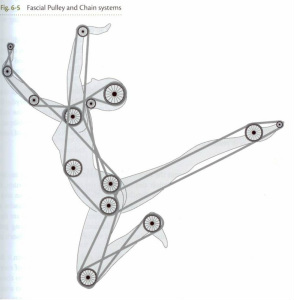
In last week's blog we talked about tension that is being applied evenly throughout the body. This is so all of the pulley wheels you see in the picture on the left will turn sequentially and allow for the joints to bend, flex and extend the way they were meant to.
Picture for a moment that one of those wheels doesn't turn, what happens to the rest of the body in movement. That disruption will cause the displacement and disproportional tension elsewhere in the body. You will also notice that the largest wheel is in the skull, as was demonstrated by percentages last week, and imagine what happens if we clench our jaw.
This brings me to today's topic, the head and neck and specifically the jaw. Many of us clench our jaw without even noticing it. There are more of us than not who have bumped our head, coughed or sneezed abruptly, maybe wore braces, and many other such traumas. Many overlook that incidental auto accident where there was no damage to the car and "I didn't have to go to the hospital!" Any and all of these alter the posture of the skull.

This is also where the most powerful muscle of the body is and it aids in moving the strongest joint in the body, the jaw. It also offers a pathway for the cranial nerves to travel between the brain and areas such as the heart, lungs, digestive system, eyes, and ears. It also houses the tongue which is an organ of the body. Your tongue is an organ, muscles are technically considered organs as well. The tongue is considered an organ because a group of tissues work together, as an organ NOT TISSUE, the reason this occurs is because the tongues tasks are too complicated to be carried out by just one type of tissue. Read more: http://wiki.answers.com/Q/Why_is_the_tongue_considered_an_organ#ixzz24IppccR4

There are techniques such as Cranio-Sacral Therapy which was developed by Dr. Sutherland, D.O. and made more mainstream by Dr. John Upledger, D.O. This technique helps to balance the structures within that aides the spinal fluid in its flow. This is the fluid that feeds your nervous system. It is a very gentle therapy.
Many of the traditional therapies also address the skull and jaw for different maladies. In Muscle Release Therapy, MRTh® we also address the skull in dealing with the internal tension on the skeleton. The skull and neck do command a larger percentage of tension to maintain proper Tensegrity throughout. The primary reason is that due to the weight of the skull, there are many attachments that allow it too move freely in flexion, extension, and rotation. All of these points need to be evaluated that they are truly pulling their own weight. Remember the tendons and muscles are the puppet strings that pull the puppet in the proper direction with the proper force.
Also, in our breathing pattern these suture lines allow the skull to expand and contract properly. Any aberration to them and it could disrupt the breathing pattern. Proper evaluation of movement is critical to the overall well being of the internal posture.
Next week we will talk about the torso and shoulders, the arms, forearms and hands and how they affect the overall internal posture to the body. But remember it is true that we need to have our head screwed on right.
Till next week, remember there is always a Reason to HOPE!
Dennis






 RSS Feed
RSS Feed
